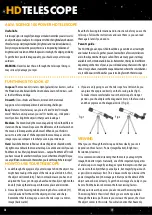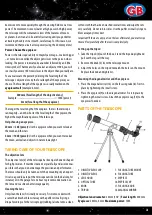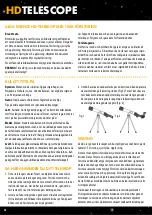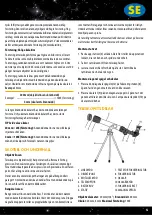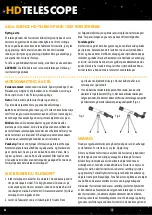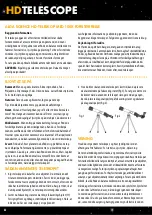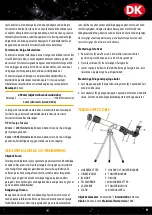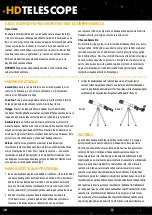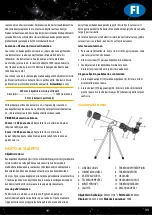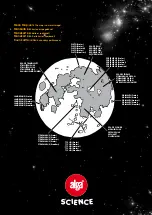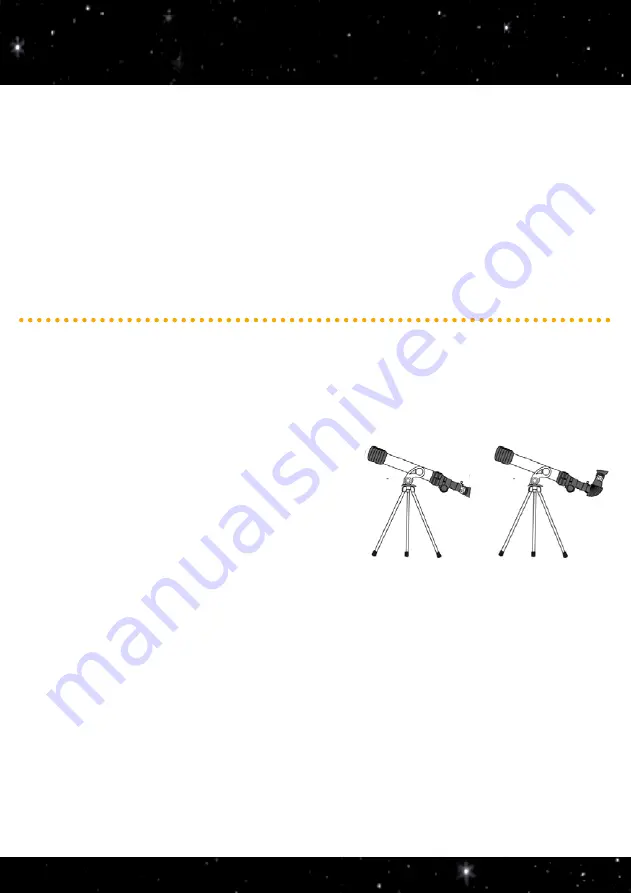
2
HD
Telescope
AlgA Science 100 Power HD TeleScoPe
Useful info
A telescope’s job is to magnify an image or make it seem like you are closer to
an object than you really are. It is important to find the right balance between
three factors: power (magnification), brightness and resolution (clearness).
Every time you increase the power, there is a corresponding reduction of
brightness and resolution. When the power is too high, the object gets blurry.
To get the best possible image quality, you should use your telescope
outdoors.
WARNING:
Never look at the sun through the telescope! Doing so
may seriously damage your eyes.
Read the following information and instructions before you use the
telescope. Follow the instructions and save them so you can read
them again later if you need to.
Parent’s guide
The first thing you and your child should do is go outside on a clear night
and look at the stars. Together, you can learn where a few constellations
are in the sky and what they are called. There are many good star maps
available on the Internet and in books. Remember, the sky looks different
depending on the time of year, so you will need a map that covers the right
time. Once you have studied the map and learned where the constellations
are, it will be easier to find what you are looking for with the telescope.
Fun THingS To look AT
In space:
The moon and its craters. Open (galactic) star clusters, such as
the Pleiades and nebulae like the Orion nebula. Learn to find stars, such
as the North Star and Vega.
On earth:
Trees, shrubs and flowers, birds and other animals.
Suggestions for simple experiments and exciting challenges
Easy.
Distance: How far away can you see? 5 km? 10 km? Or maybe
more? How far out in space can you see? It’s hard to say – it depends
mostly on how bright the object is that you are looking at.
Medium.
The moon: Study the moon map and try to find the different
craters on the real moon. Do you see the difference on the surface when
the moon is full compared to a half-moon? When do you think it is
easiest to see the craters? We have printed the moon map as a mirror-
image so you can compare it to what you see in your telescope.
Hard.
Search the Internet to find out where the planets should be in the
sky right now, and mark them on a star map. Go outside and see if you can
find them. Venus, Mars, Jupiter and Saturn – can you find them all? Or will
you have to wait for another time of year, or another time of night? Do you
see any differences between them when you look through the telescope?
How To uSe your TeleScoPe
1. Look through the eyepiece of your telescope to find the object. You
might have to adjust the angle of the telescope a little bit. At first,
the object will seem blurry. That is normal, because you have not
adjusted the focus yet. Once you have found the object, tighten the
knob (5) to keep the telescope in the same place and direction.
2. Now adjust the focusing tube by turning the focuser knob (11)
slowly back and forth until the object gets clear and sharp.
Remember that the image you see in the telescope is a mirror-
image (backwards).
3. If you are only going to use the telescope for a little while, you
can place the eyepiece directly on the focusing tube (Fig.1).
To make it more comfortable to use the telescope for longer
periods, you should place the diagonal mirror on the focus tube
and the eyepiece on the diagonal mirror (Fig. 2).
Viewing
What you see through the telescope and how clearly you see it
depends on three factors: Power (magnification), Brightness,
Resolution (clearness)
It is a common misunderstanding that the more you magnify the
image, the better it gets. Naturally, one of the important properties
of a telescope is to magnify an image or give the impression that you
are closer to the object than you really are, but magnifying as much
as possible is not always best. This is because when you increase the
power (magnification), the image gets blurry and the details of the
object cannot be seen clearly. To get the best image of an object, you
have to find the balance between the three viewing factors.
When you increase the power, you also reduce the viewing field.
The viewing field is the circle of the sky you see when you look
through the telescope. The more you increase the power, the closer
the object comes to this circle. You will also notice that heavenly
Fig.1
Fig.2


